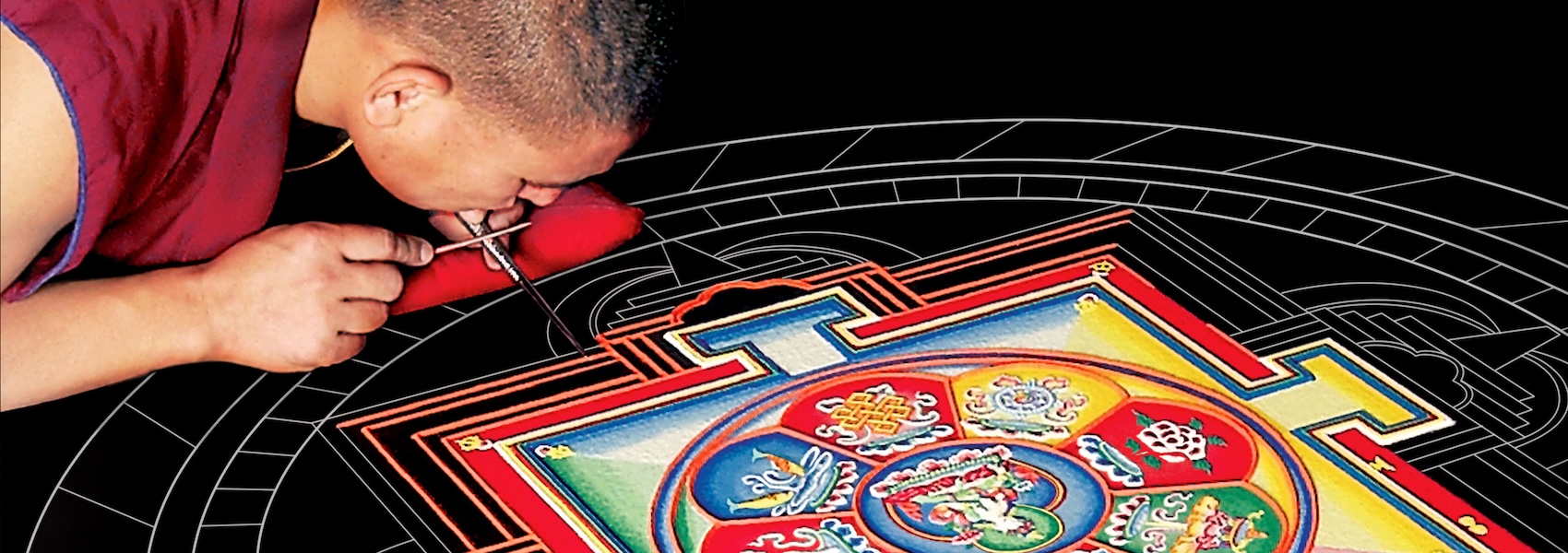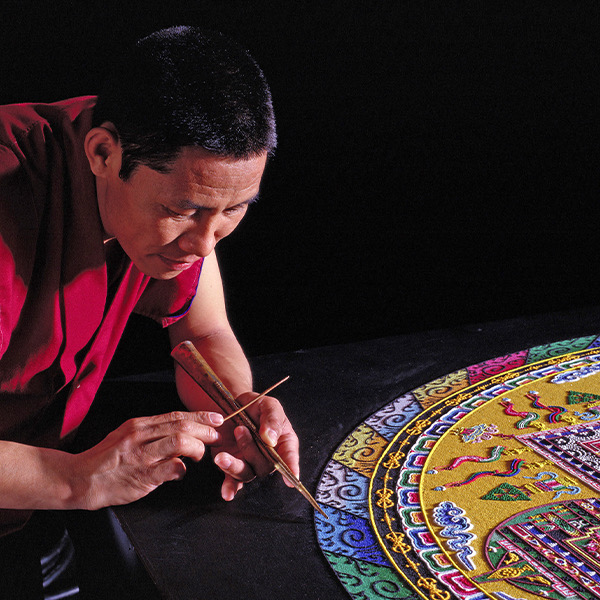Mystical Arts of Tibet
- Monday, April 6–Friday, April 10
- Old Chapel
Introduce your students to Tibet’s vibrant culture, profound spirituality, and captivating artistry with the Mystical Arts of Tibet. As Buddhist monks from the Drepung Loseling Monastery create an intricately designed sand mandala more than a million grains of colored sand, students will have the opportunity to observe the process and learn about Buddhism through sacred art. Each student will also create and take home their own mandala and participate in a brief introduction to mindfulness.
What Will My Students Experience?
During this hour-long journey, students will visit the Old Chapel on the UMass Amherst campus to watch monks from the Drepung Loseling Monastery create an intricate sand mandala that reflects the spiritual and artistic heritage of Tibet. The mandala is made by painstakingly placing millions of grains of sand onto a flat surface over the course of one week.
Students will also create and take home their own mandala and learn how this sacred art is used for meditation and spiritual growth through a brief introduction to mindfulness.
What Will My Students Learn?
Students will gain a deeper understanding of Tibetan culture and Buddhism through their visit to the Mystical Arts of Tibet.
They will learn about the significance of sacred art forms such as sand mandalas, thangka paintings, prayer wheels, and prayer flags, and how these practices reflect the spiritual beliefs and values of Tibetan Buddhism.
Students will explore themes of impermanence, compassion, and interconnectedness and will appreciate the intricate craftsmanship involved in creating these artworks.
This experience will also foster global awareness and cultural sensitivity, encouraging students to reflect on the similarities and differences between Tibetan traditions and their own cultural practices.
Please scroll down to the section titled “Educational Standard Alignment” for a list of relevant standards selected from state and national frameworks.
How Can I Connect This to What I Am Teaching?
Regardless of what grade level you are teaching, there are many ways to connect a visit to see the Mystical Arts of Tibet to what your students are currently learning.
Here are few ideas to help you get started:
-
Help social studies students explore the history of Tibet, its cultural heritage, and the significance of Tibetan Buddhism.
-
Encourage English language arts students to read and analyze Tibetan folktales and stories, discussing themes, morals, and cultural values.
-
Inspire visual arts students to create their own mandalas, learning about the symbolism and artistic techniques used in Tibetan sand mandalas. Or, study traditional Tibetan thangka paintings and their religious significance by creating their own versions.
-
Invite creative writing students to explore Tibetan poetry and its connection to spirituality and nature.
-
Teach physical education students to incorporate mindfulness practices into their daily lives and learn yoga inspired by Tibetan traditions.
-
Introduce music students to traditional Tibetan music to understand its role in rituals and daily life.
Please scroll down to the section titled “What About the Standards?” for a list of relevant standards selected from state and national frameworks.
What Should I Know?
The Mystical Arts of Tibet program is an initiative endorsed by the Dalai Lama. The program aims to promote world peace and healing through the rich and sacred arts of Tibet.
This program, featuring the monks of the Drepung Loseling Monastery, includes mesmerizing performances of multiphonic chanting, traditional music, and the intricate creation of Mandala sand paintings.
These events offer a rare glimpse into one of the world's most ancient spiritual traditions, combining visual and performing arts to create an unforgettable experience. Additionally, the program includes educational outreach through lectures, workshops, and exhibitions, providing deeper insights into Tibetan philosophy, meditation, and culture.
A Closer Look
Tibetan Buddhism, also known as Vajrayana Buddhism, is a unique form of Buddhism that evolved in Tibet and the Himalayan region. It combines the teachings of Mahayana Buddhism with esoteric practices and rituals, emphasizing the path to enlightenment through compassion, wisdom, and meditation.
Central to Tibetan Buddhism are the concepts of reincarnation and the role of the Dalai Lama, who is considered the spiritual leader and a manifestation of the Bodhisattva of Compassion. The tradition is rich in symbolism, art, and chanting, with practices such as the creation of intricate sand mandalas and the use of prayer wheels and flags. Tibetan Buddhism not only offers profound spiritual insights but also promotes a deep sense of interconnectedness and harmony with all living beings.
Sacred Art
Sacred art holds profound importance in Tibetan Buddhism, serving as a visual representation of spiritual teachings and practices. It includes thangka paintings, mandalas, and statues, each imbued with deep symbolic meaning and used as tools for meditation and devotion.
These artworks are not merely decorative; they are considered manifestations of the divine, aiding practitioners in their spiritual journey by providing a focus for contemplation and a means to connect with higher states of consciousness. Sacred art also plays a crucial role in preserving and transmitting the rich cultural and religious heritage of Tibetan Buddhism, ensuring that its teachings and values continue to inspire and guide future generations.
Sand Mandalas
A Tibetan sand mandala is a meticulously crafted, intricate design made from colored sand, representing the universe in Tibetan Buddhism.
Created by monks over several days or weeks, the mandala is a tool for meditation and symbolizes the impermanence of life. Each element within the mandala holds deep spiritual significance, reflecting the teachings of the Buddha.
Once completed, the mandala is ceremoniously dismantled, and the sand is dispersed into a body of water, symbolizing the transient nature of existence and spreading blessings to the world. This practice is profoundly important to the people of Tibet as it embodies their spiritual beliefs and cultural heritage.
Prayer Wheels
A Tibetan prayer wheel, known as a "mani wheel," is a cylindrical device inscribed with sacred mantras, most commonly "Om Mani Padme Hum." When spun, it is believed to release prayers into the universe, spreading spiritual blessings and positive energy.
For the people of Tibet, prayer wheels are an essential part of their daily spiritual practice, symbolizing the continuous cycle of life and the power of compassionate intentions. They are often used during meditation and prayer, helping practitioners focus their minds and cultivate inner peace.
Flags
Tibetan prayer flags are colorful rectangular cloths, often found strung along mountain ridges and peaks in the Himalayas. Each flag is inscribed with prayers, mantras, and symbols, and they come in five colors representing the elements: blue (sky), white (air), red (fire), green (water), and yellow (earth).
When the wind blows, it carries the prayers and blessings inscribed on the flags into the surrounding environment, spreading goodwill and compassion.
For the people of Tibet, prayer flags are a vital part of their spiritual practice, symbolizing the interconnectedness of all beings and the impermanence of life. They serve as a constant reminder of the importance of peace, harmony, and the wellbeing of all living things.
Geography
The landscape of Tibet, often referred to as the "Roof of the World," is deeply intertwined with its Buddhism and culture. The towering Himalayan mountains, vast plateaus, and serene lakes are not only breathtaking but also hold significant spiritual meaning.
The harsh yet majestic environment has shaped the resilient and spiritual nature of the Tibetan people, influencing their practices and way of life. Monasteries and temples are often built in remote, elevated locations, symbolizing the journey towards higher states of consciousness and enlightenment.
Think About It
Consider any iteration of the following questions to help deepen your students’ understanding of the Mystical Arts of Tibet.
-
What aspects of Tibetan culture did you find most interesting or surprising? Why?
-
How do the symbols and colors used in Tibetan art and mandalas reflect the beliefs and values of Tibetan Buddhism?
-
How do you think creating a sand mandala or a thangka painting might help someone in their spiritual practice?
-
The dismantling of sand mandalas symbolizes the impermanence of life. How does this concept compare to ideas about life and change in other cultures or religions you know?
-
How do you think the natural environment of Tibet influences its art and spiritual practices?
-
How can the principles and practices of Tibetan Buddhism, such as compassion and mindfulness, be applied to address current global issues?
Educational Standards Alignment
While the following list is not a complete list of applicable standards, it does provide a set (or examples) of relevant standards you can use to develop lessons in line with national and state educational standards and requirements.
Massachusetts 2018 Curriculum Framework for History and Social Science
Grade 7 Content Standards
Topic 2. East Asia [7.T2]
b. Early East Asian societies, religions, and cultures Ancient China, c. 1600 BCE–500 CE [7.T2b]
2. Describe important economic, political, and religious developments in early Chinese history and evaluate the ways in which they are similar to or different from the characteristics of societies in other regions of the world.
f. China’s role in trade across Asia and to and from Africa and Europe along the Silk Roads and the introduction of Buddhism in China starting c. 1st century CE.
World History I Content Standards
Topic 2. Development and diffusion of religions and systems of belief c. 500 BCE–1200 CE [WHI.T2]
Supporting question: How did the development of religions and belief systems influence the political and cultural structures of the regions where they were produced?
2. Describe the central tenets of Hinduism, Judaism, Buddhism, Confucianism, Christianity, and Islam; create a timeline that shows when and where each religion or belief system began.
Clarification Statement: Students should understand that religions are not monolithic entities, and that each religion mentioned in the standards has historically had a diversity of traditions, practices, and ideas, and continues to do so today.
5. Locate on a map and analyze relationships between political power, religion, and cultural achievement in one empire that flourished between c.100 and 1000 CE.
a. the Kushan Empire (c. 1st–5th centuries) with its fusion of Greco-Roman and Buddhist culture and imagery in Gandharan sculpture; the Gupta Empire (c. 320–600 CE), uniting multiple kingdoms of North, Central, and Southeast India, religious tolerance for Hinduism, Buddhism and Jainism; highly developed Hindu and Buddhist sculpture and literature.
National Core Arts Standards
VA:Re.7.1 Anchor Standard: 7. Perceive and analyze artistic work.
VA:Re.7.1.6.a - Identify and interpret works of art or design that reveal how people live around the world and what they value.
7th Grade
VA:Re.7.1.7.a - Explain how the method of display, the location, and the experience of an artwork influence how it is perceived and valued.
8th Grade
VA:Re.7.1.8.a - Explain how a person’s aesthetic choices are influenced by culture and environment and impact the visual image that one conveys to others.
CASEL Competencies (Social and Emotional Learning)
Social Awareness (Recognizing strengths in others)
The ability to understand the perspectives of and empathize with others, including those from diverse backgrounds, cultures, and contexts. This includes the capacities to feel compassion for others; understand broader historical and social norms for behavior in different settings; and recognize family, school, and community resources and supports.






